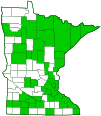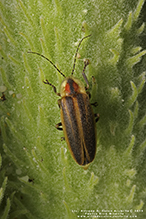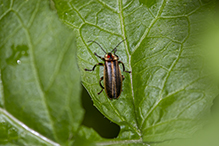fireflies
(Photuris spp.)
Overview • Description • Distribution • Taxonomy
Description |
Adults are soft-bodied, flattened, elongate, and 5 ⁄16″ to ¾″ (8 to 20 mm) in length. When viewed from above, the head is often partly exposed, but it can be retracted defensively. The antennae are slender and thread-like, not saw-toothed. The forewings (elytra) are leathery and are folded over the body when at rest. When folded, a small portion of the abdomen in the shoulder (humeral) area is exposed. This is only visible when viewed from the side. Called an incomplete elytral fold, this feature, along with the partially exposed head, distinguishes Photuris from similar Photinus fireflies. The legs are long and slender but not compressed. The last part of each leg (tarsus), corresponding to the foot, has five segments, but the fourth segment is minute and is concealed within the lobes of the heart-shaped third segment, making it appear that there are only four segments. There is a pair of claws at the end of the last segment. The front half of each claw is split (cleft). |
Distribution |
||
|
Sources |
|
| 10/16/2024 | ||
Taxonomy |
|
Order |
Coleoptera (Beetles) |
Suborder |
Polyphaga (Water, Rove, Scarab, Long-horned, Leaf, and Snout Beetles) |
Infraorder |
Elateriformia |
Superfamily |
Elateroidea (click, firefly and soldier beetles) |
Family |
|
Subfamily |
Photurinae |
Tribe |
Photurini |
Subordinate Taxa |
|
belted firefly (Photuris cinctipennis) Bethany Beach firefly (Photuris bethaniensis) Cape Breton firefly (Photuris fairchildi) changeable firefly (Photuris versicolor) Christmas lights firefly (Photuris tremulans) common eastern mimic (Photuris pyralomima) cypress firefly (Photuris walldoxeyi) Everglades brownwing firefly (Photuris floridana) fast crescendo (Photuris moorei) firefly (Photuris appalachianensis) firefly (Photuris aureolucens) firefly (Photuris divisa) firefly (Photuris eliza) firefly (Photuris lineaticollis) firefly (Photuris lloydi) firefly (Photuris missouriensis) Florida single snappy (Photuris congener) heebie-jeebies firefly (Photuris hebes) July comets (Photuris lucicrescens) loopy five firefly (Photuris forresti) mysterious lantern firefly (Photuris mysticalampas) Pennsylvania firefly (Photuris pensylvanica) Potomac River firefly (Photuris potomaca) salt marsh firefly (Photuris salina) Sky Island firefly (Photuris flavicollis) slow blue (Photuris caerulucens) snappy single sync (Photuris frontalis) spring 4-flasher (Photuris quadrifulgens) |
|
Synonyms |
|
|
|
Common Names |
|
This genus has no common name. The common name of the family Lampyridae is fireflies, and it is used here for convenience. |
|
Glossary
Elytra
The hardened or leathery forewings of beetles used to protect the fragile hindwings, which are used for flying. Singular: elytron.
Tarsus
On insects, the last two to five subdivisions of the leg, attached to the tibia; the foot. On spiders, the last segment of the leg. Plural: tarsi.
Visitor Photos |
||
Share your photo of this insect. |
||
This button not working for you? |
||
Alfredo Colon |
||
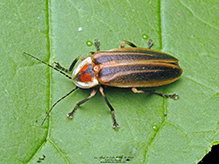 |
||
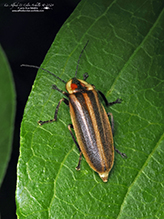 |
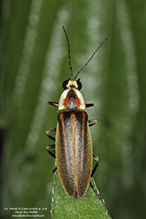 |
|
|
||
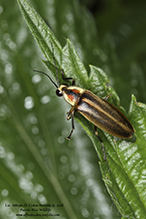 |
||
MinnesotaSeasons.com Photos |
||
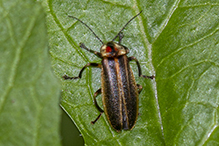 |

Slideshows |
|

Visitor Videos |
||
Share your video of this insect. |
||
This button not working for you? |
||
|
Other Videos |
||
So ... Sometimes Fireflies Eat Other Fireflies | Deep Look |
About
Feb 27, 2018 Most firefly flashes are pure romance, a sexy form of skywriting. But one variety copies the mating signals of others to lure them to their demise. |
Photuris Firefly (Lampyridae: Photuris) on Leaf |
About
Jul 2, 2011 Photographed at the Rydell NWR, Minnesota (29 June 2011). |
FIRELFLY, Photuris resting |
About
Dec 9, 2019 FIRELFLY, Photuris resting.McClaughery Springs FP, IL 8/1/2019 |

Visitor Sightings |
||
Report a sighting of this insect. |
||
This button not working for you? |
||
Alfredo Colon |
Location: Albany, NY |
 |
Alfredo Colon |
Location: Albany, NY |
 |
| Alfredo Colon 8/6/2019 |
Location: Woodbury, MN |
 |
| Alfredo Colon 7/6/2018 |
Location: Woodbury, MN |
 |
MinnesotaSeasons.com Sightings |
||

Created: 8/27/2023 Last Updated: © MinnesotaSeasons.com. All rights reserved. |
